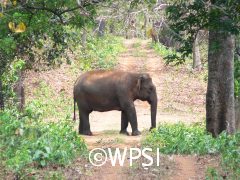|
 |
Home :: Projects :: Elephant Habitat Assessment
|
‘Corridor to Survival’ - Landscape Conservation Plan for Elephant Management
Since 1987, large numbers of elephants from Dalma Hills, in East
Singbhum district of Jharkhand, have been entering the densely
populated districts of Midnapore and Bankura in West Bengal.
Predictably, this has resulted in human-elephant conflict of enormous
proportion.
 In 2003, the Singhbhum Elephant Study was initiated by the Wildlife
Protection Society of India (WPSI) to assess the probable reasons why
wild elephants have been leaving the well-forested Dalma Wildlife
Sanctuary in Jharkhand, and moving into locations wholly unsuited to
these high-consuming animals. The study successfully identified the
dissection of traditional transit paths - through Paschmi Singbhum in
Jharkhand and into Keonjhar district of Orissa - as one of the reasons
why the elephants had selected such unlikely places as post-monsoon
habitat. It was the first such research on the dispersal behaviour of
the Singbhum elephants
The ‘Corridor to Survival’
project initiated in May 2006, was a natural sequel to the Singhbhum
Elephant Study. It was largely designed to: (i) identify the causes for
disruption of the elephants’ transition paths through traditional
use areas, (ii) map the Elephant Transit Paths (ETPs) of the recent
past, (iii) identify present paths connecting northern Orissa with
Jharkhand, and (iv) assess the habitat status in relation to
biogeography of the use areas. The primary aim of the study was to
develop a Management Plan for Elephant Landscape Design. This included
the development of site-specific habitat management procedures for the
re-creation of lost transit paths, that would ensure the
uninterrupted movement of elephants between the northern limits of
their traditional distribution range at Dalma Hills in Jharkhand, to
Keonjhar in Orissa.
This is no easy task. The elephants have to cross two canals near Dalma
 Wildlife Sanctuary in Jharkhand, railway crossings, human habitation,
and finally a web of iron ore mines. But miraculously it is feasible,
for there are still patches of forests with sufficient seasonal food
through their traditional migration routes.
The present study has found that small groups of elephants have started
venturing south of Dalma into the Seraikella Forest Division, and then
further down towards the jungles of Saranda in Jharkhand, bordering the
Orissa highlands. Unfortunately, here the elephants face a predicament
worse than any in the past - the destruction of their traditional
transit paths by open-cast iron ore mines. The recent rise in demand
for iron ore in domestic as well as international markets has ensured
the diversion of large patches of forests for mining. Presently, more
than 100 leases are in operation in the northern mining belt of
Keonjhar district in Orissa, in addition to other industrial units that
have been set up to support the mines. The mining boom became apparent
here in 2002, around the same time that the Olympics Games was
announced in China. The world experienced an  unprecedented growth in
demand for finished steel, which in turn created a rise in demand for
iron ore, the raw material need for steel manufacturing. Beneath the
1,500 km2 of well-forested land in the Keonjhar and Sundergarh
districts of Orissa and the Paschimi Singhbum district of Jharkhand,
lies an estimated 5 billion tons of high-grade iron ore.
In Jharkhand and Orissa, 2,000 and almost 5,000 hectares respectively,
of prime Elephant habitat is now under the miners’ shovels,
erasing all signs of the forest corridors that have been used by
elephants for thousands of year. This has forced the wild elephants to
move into areas where they have not been recorded in the recent past,
and has resulted in a phenomenal rise in human-elephant conflict. The
enormity of the threat to the survival of wild elephants in eastern
India can be clearly seen by comparing records of elephant mortality,
before and after the increase in mining activities in the region (see
chart).
Project Achievements
- This is the first micro-level, on-foot distribution and landscape study of wild elephants undertaken in India.
- An overview of forests in elephant-use
areas, and past and present elephant transit paths (ETPs), has been
completed in Orissa’s Sundergarh, Keonjhar and Angul districts.
Sambalpur, Dhenkanal and Mayurbanj are left. In the state of Jharkhand,
an overview has been completed in all three elephant-bearing districts
- Paschimi Singbhum, Purbhi Singbhum and Sarai Kella.
- The project team has identified suitable
alternative ETPs in the areas mentioned above, and is in the process of
developing the necessary methodology for re-creating ETPs that may be
used by groups of elephants that are presently isolated. This would
allow them access to traditional foraging areas. We are in contact with
user agencies in Jharkhand and Orissa, such as mine owners, forest
departments, irrigation departments, district administrations and
villagers.
- The state Forest Departments are strongly
supporting the study and some of the short-term recommendations have
already been implemented. Open cast mines are a serious threat to
transiting elephants between home ranges spread over two states.The
Principal Chief Conservator of Forests and Divisional Forest Officers
(DFOs) of Orissa helped WPSI organise a meeting with mine owners and
managers in the town of Joda. The turnout was excellent. The miners
showed support for the project and agreed to certain recommendations,
such as regulating timings for dynamite blasts and the regeneration of
elephant transit paths which fall within their mine lease areas.
Constant follow-up with different iron ore mine owners of the region,
have already encouraged them to consider several of our suggestions
that would ensure safe access through their leasehold areas.
- Based on the study, the Forest Department
has also come down heavily on both mining and the use of crushing
plants at night. In one remote village called Potuakudur, where
human-elephant conflict is common, the DFO has constructed a six feet
high stone wall along an important elephant transit path. The
wall’s construction has been completed and a two km gap has been
left, to allow elephants and other animals to cross from one forest
patch to another without coming into conflict with the village or
passing fields in between. Such measures will greatly improve the
long-term viability of elephant transit paths.
- Over the past 18 months, several field
visits and meetings in the state capitals of Orissa and Jharkhand have
yielded unexpectedly encouraging results and many crucial suggestions
have either been executed or are in an advanced stage of being
implemented. There are a number of other recommendations that need to
be pursued vigorously.
- Our Corridor to Survival project pointed
out to the state authorities the gross irregularities in the EIA report
still being followed by the Khanpur/Baitarani Irrigation Project that
would submerge a vitally important elephant corridor in Keonjhar
district in Orissa, along with nine villages to be submerged completely
and seven partially. Follow-up action has already prompted the decision
to insist that the project proponents should conduct another updated
EIA/EMP before proceeding with any further construction work.
- The wildlife directorates of both
Jharkhand and Orissa, are depending on the findings of this project for
their official Management Plans and have insisted on our participation
in both the planning and execution stage of different action plans.
- Aware of the negative repercussions of
the Khanpur/Baitarani Irrigation Project, WPSI has brought to the
notice of the Orissa authorities the ongoing construction of a massive
irrigation canal under the Rengali Irrigation Project. The Project
authorities are digging two main canals (on both sides of the Brahmani
River) with a maze of subsidiary irrigation channels originating from
the Samal barrage in Dhenkanal district. The length of the left bank
and right bank canals will be 141 and 112 km, respectively. Of this, 30
km along the left bank has already been completed. A huge area of
elephant habitat falls within the direct impact zone of the project and
almost the entire length of the canal system would pass through forests
used by wild elephants, either as home ranges or transit paths. In
order to mitigate the impact of the canal system, our Project Manager
was requested by the PCCF & CWLW, Orissa, to assist in the
preparation of an Elephant Management Action Plan.
- The Action Plan has now been accepted by
the Orissa Forest Department and is ready to be implemented. The
salient recommendations are:
- Construction of elephant-friendly, transit ramps
- Construction of elephant-proof, energized fences and rubble walls
- Water Management, including water harvesting structures
- Grass plot development
- Habitat manipulation, including Eupatorium eradication
- Creation of forest protection squads and vigil huts
- Human resource development, including capacity building for forest personnel at the forest training college
|
|
 |
Untitled Document
|